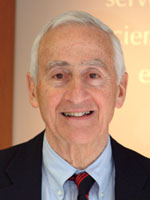
Roy Vagelos
Merck (retired)
A Pipsqueak Among Giants
In the course of my career I was fortunate to have worked in government, academia, and industry, where I eventually became the CEO of Merck. I started on this path in 1956, when I took a postdoctoral position in biochemistry with Earl Stadtman at the National Institutes of Health (NIH). It was an unusual arrangement for both of us: for the first time, Earl was bringing an M.D. instead of a Ph.D. into his laboratory, and in addition to caring for patients with heart disease, I agreed to spend half my time doing research. I dove into biochemistry, starting with a textbook that Earl gave me, and in 1958 Earl set me on a path of independent research into fatty acid metabolism.
In 1963 I was invited to my first Lipid Metabolism Gordon Research Conference. It was an incredible honor to share the podium with senior researchers, including Konrad Bloch of Harvard University, Irving Fritz of the University of Michigan, and Salih Wakil of Duke University. There I was, a pipsqueak only a few years out of a postdoctoral fellowship, speaking alongside these giants of biochemistry. In 1965 I presented alongside Wakil and Feodor Lynen of the Max Planck Institute in Germany, who was a buddy of Earl’s and shared the 1964 Nobel Prize with Konrad for work on cholesterol synthesis. Bloch, Wakil, Lynen, and I were all competing to understand fatty acid biosynthesis. In 1953 Fritz Lipmann, with whom Earl had worked as a postdoctoral fellow at Massachusetts General Hospital, won half the Nobel Prize in physiology or medicine for discovering coenzyme A (CoA), a molecule critical to fatty acid metabolism. Lynen showed exactly how CoA was involved in fatty acid breakdown. Wakil and I simultaneously but independently discovered the acyl carrier protein, which my team later found was the single protein to which all the intermediates of fatty acid synthesis are bound. We were ardent competitors.
This collection of individuals demonstrated the greatest strength of the Gordon Conferences: they operated without hierarchy. Attendees, including young biochemists like myself, were selected by chairs on the basis of the exciting research they were doing that year. It was amazing to sit with people who were significantly older and much more accomplished and be in a position to swap information with them. I come from a modest background and have always had to work hard for my achievements, so it was both inspiring and intimidating to be competing eyeball to eyeball with senior researchers. The Gordon Conferences allowed you to get to know the work of leading scientists and also to get to know them personally while you were eating together, fishing, or socializing. For example, I played a lot of tennis with Harvard biochemist Eugene Kennedy. Even when you were in the heat of competition with someone, like I was with Konrad, there was still always a sense of collegiality and camaraderie. Konrad and I got to know each other well, and he later invited me to be a visiting professor at Harvard. Perhaps most important, however, Gordon Conference meetings made me realize that our NIH research group was capable of moving our work along as fast as our competitors. We were able to show that acyl carrier protein contains half
of the CoA molecule. Despite being young, we had the insight to take big leaps in our work.
In 1966 I moved on to chair the biological chemistry department at Washington University Medical School, and by 1969 it was my turn to chair the Lipid Metabolism Conference. Trading information at GRCs continued to be extremely productive for my work. Because of the relationships of fatty acids to complex lipids and phospholipids, I learned a lot from other researchers in these disciplines. Later I also learned about steroids. Without having planned it, my career moved into these areas. I went from fatty acid metabolism into complex lipids and ultimately into cholesterol research. This got me thinking about the biosynthesis of cholesterol. The idea of using mutant
Escherichia coli bacteria to modify the genes responsible for unsaturated fatty acid synthesis at the NIH laboratory came from microbial geneticists I met at Gordon Conferences. That led our research group to use sterol biosynthetic enzyme mutations in Chinese hamster ovary cells to prove that cells needed cholesterol. At Merck in the 1970s and 1980s our researchers showed that inhibition of the enzyme HMG-CoA reductase caused cholesterol levels to decrease and thus demonstrated that reduction in blood cholesterol was beneficial to human health. These insights contributed to Merck’s development of the cholesterol-reducing drugs Mevacor and Zocor.
There was little premeditation in the course of my career: it just happened that I was at Gordon Conferences where these topics were being discussed. The breadth of my research grew enormously through both the informal and formal GRC sessions. I did not get stuck in fatty acid metabolism all my life in part because I met people from different fields at these meetings. I used this background as the first step in drug discovery at Merck, which opened doors to the path I traveled to corporate leadership.